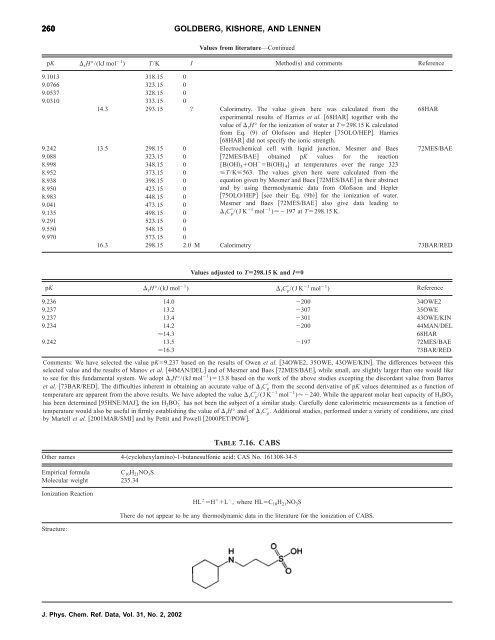Thermodynamic Quantities for the Ionization Reactions of Buffers
Thermodynamic Quantities for the Ionization Reactions of Buffers
Thermodynamic Quantities for the Ionization Reactions of Buffers
Create successful ePaper yourself
Turn your PDF publications into a flip-book with our unique Google optimized e-Paper software.
260 GOLDBERG, KISHORE, AND LENNEN<br />
Values from literature—Continued<br />
pK rH°/(kJ mol 1 ) T/K I Methods and comments Reference<br />
9.1013 318.15 0<br />
9.0766 323.15 0<br />
9.0537 328.15 0<br />
9.0310 333.15 0<br />
14.3 293.15 ? Calorimetry. The value given here was calculated from <strong>the</strong><br />
experimental results <strong>of</strong> Harries et al. 68HAR toge<strong>the</strong>r with <strong>the</strong><br />
value <strong>of</strong> rH° <strong>for</strong> <strong>the</strong> ionization <strong>of</strong> water at T298.15 K calculated<br />
from Eq. 9 <strong>of</strong> Ol<strong>of</strong>sson and Hepler 75OLO/HEP. Harries<br />
68HAR did not specify <strong>the</strong> ionic strength.<br />
9.242 13.5 298.15 0 Electrochemical cell with liquid junction. Mesmer and Baes<br />
9.088 323.15 0<br />
8.998 348.15 0<br />
8.952 373.15 0<br />
8.938 398.15 0<br />
8.950 423.15 0<br />
8.983 448.15 0<br />
9.041 473.15 0<br />
9.135 498.15 0<br />
9.291 523.15 0<br />
9.550 548.15 0<br />
9.970 573.15 0<br />
72MES/BAE obtained pK values <strong>for</strong> <strong>the</strong> reaction<br />
BOH 3OH BOH) 4 at temperatures over <strong>the</strong> range 323<br />
T/K563. The values given here were calculated from <strong>the</strong><br />
equation given by Mesmer and Baes 72MES/BAE in <strong>the</strong>ir abstract<br />
and by using <strong>the</strong>rmodynamic data from Ol<strong>of</strong>sson and Hepler<br />
75OLO/HEP see <strong>the</strong>ir Eq. 9b <strong>for</strong> <strong>the</strong> ionization <strong>of</strong> water.<br />
Mesmer and Baes 72MES/BAE also give data leading to<br />
rC p /(J K 1 mol 1 )197 at T298.15 K.<br />
68HAR<br />
72MES/BAE<br />
16.3 298.15 2.0 M Calorimetry 73BAR/RED<br />
Values adjusted to TÄ298.15 K and IÄ0<br />
pK rH°/(kJ mol 1 ) rC p /(J K 1 mol 1 ) Reference<br />
9.236 14.0 200 34OWE2<br />
9.237 13.2 307 35OWE<br />
9.237 13.4 301 43OWE/KIN<br />
9.234 14.2 200 44MAN/DEL<br />
14.3 68HAR<br />
9.242 13.5 197 72MES/BAE<br />
16.3 73BAR/RED<br />
Comments: We have selected <strong>the</strong> value pK9.237 based on <strong>the</strong> results <strong>of</strong> Owen et al. 34OWE2, 35OWE, 43OWE/KIN. The differences between this<br />
selected value and <strong>the</strong> results <strong>of</strong> Manov et al. 44MAN/DEL and <strong>of</strong> Mesmer and Baes 72MES/BAE, while small, are slightly larger than one would like<br />
to see <strong>for</strong> this fundamental system. We adopt rH°/(kJ mol 1 )13.8 based on <strong>the</strong> work <strong>of</strong> <strong>the</strong> above studies excepting <strong>the</strong> discordant value from Barres<br />
et al. 73BAR/RED. The difficulties inherent in obtaining an accurate value <strong>of</strong> rC p from <strong>the</strong> second derivative <strong>of</strong> pK values determined as a function <strong>of</strong><br />
temperature are apparent from <strong>the</strong> above results. We have adopted <strong>the</strong> value rC p /(J K 1 mol 1 )240. While <strong>the</strong> apparent molar heat capacity <strong>of</strong> H3BO 3<br />
has been determined 95HNE/MAJ, <strong>the</strong> ion H 2BO 3 has not been <strong>the</strong> subject <strong>of</strong> a similar study. Carefully done calorimetric measurements as a function <strong>of</strong><br />
temperature would also be useful in firmly establishing <strong>the</strong> value <strong>of</strong> rH° and <strong>of</strong> rC p . Additional studies, per<strong>for</strong>med under a variety <strong>of</strong> conditions, are cited<br />
by Martell et al. 2001MAR/SMI and by Pettit and Powell 2000PET/POW.<br />
TABLE 7.16. CABS<br />
O<strong>the</strong>r names 4-cyclohexylamino-1-butanesulfonic acid; CAS No. 161308-34-5<br />
Empirical <strong>for</strong>mula C 10H 21NO 3S<br />
Molecular weight 235.34<br />
<strong>Ionization</strong> Reaction<br />
Structure:<br />
J. Phys. Chem. Ref. Data, Vol. 31, No. 2, 2002<br />
HL H L , where HLC 10H 21NO 3S<br />
There do not appear to be any <strong>the</strong>rmodynamic data in <strong>the</strong> literature <strong>for</strong> <strong>the</strong> ionization <strong>of</strong> CABS.
















